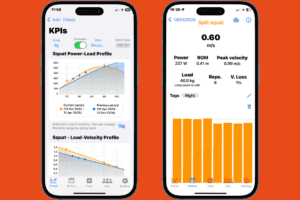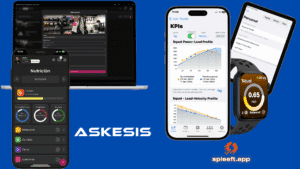Nel mondo in continua evoluzione del fitness e dell'allenamento di resistenza, atleti e allenatori sono costantemente alla ricerca di modi per ottimizzare le prestazioni, gestire la fatica e ottenere risultati misurabili. Uno dei progressi più promettenti in questo campo è l'integrazione di Ripetizioni in riserva (RIR) E allenamento basato sulla velocità (VBT)Questi metodi, se combinati con tecnologie all'avanguardia come App di Spleeft, offrono un approccio all'allenamento scientificamente supportato che massimizza l'efficienza e riduce al minimo il rischio di sovrallenamento.
In questo blog approfondiremo i principi scientifici alla base di RIR e VBT, esploreremo la loro relazione e spiegheremo come l'app Spleeft sfrutta questi principi per aiutarti ad allenarti in modo più intelligente, non più intenso.
SCARICA ORA L'APP SPLEEFT PER iOS, ANDROID E APPLE WATCH!
Rappresentanti in riserva (RIR):
Cosa sono le Ripetizioni in Riserva (RIR)?

Repetitions in Reserve (RIR) è un metodo utilizzato per valutare e prescrivere l'intensità dell'esercizio durante l'allenamento di resistenza. Si riferisce al numero di ripetizioni che un individuo ritiene di poter eseguire prima di raggiungere il cedimento muscolare. Ad esempio, se completi una serie di distensioni su panca e ritieni di poterne fare altre due prima di cedere, il tuo RIR per quella serie è 2.
RIR ha guadagnato popolarità perché fornisce un modo pratico per gestire l'intensità dell'allenamento senza spingere il corpo al completo cedimento. Questo approccio aiuta gli atleti a bilanciare carico di lavoro e recupero, il che è fondamentale per il progresso a lungo termine.
La scienza alla base dell'RIR e dell'allenamento basato sulla velocità
Ricerche recenti hanno esplorato la relazione tra RIR e velocità media assoluta durante gli esercizi di resistenza. Questa relazione, nota come Relazione RIR-velocità, ha implicazioni significative per l'ottimizzazione dell'allenamento. Ecco cosa ci dice la scienza:
1. Relazioni individuali vs. generali tra velocità RIR
Gli studi hanno dimostrato che le relazioni individuali RIR-velocità sono più accurate di quelle generali. In altre parole, ogni atleta ha una relazione unica tra la propria velocità di movimento e il numero di ripetizioni che può eseguire prima del cedimento.
Ad esempio, la ricerca ha dimostrato che le singole relazioni RIR-velocità stabilite in una sessione di test possono prevedere RIR con un errore medio inferiore a 2 ripetizioni nelle sessioni successive, indipendentemente dal carico utilizzato. Ciò significa che un singolo profilo RIR-velocità può essere utilizzato su una gamma di carichi, rendendolo uno strumento versatile per la prescrizione dell'allenamento.
2. Perdita di velocità e RIR
La perdita di velocità si riferisce alla diminuzione della velocità di movimento durante una serie di esercizi di resistenza. Gli studi hanno scoperto che la perdita di velocità è maggiore quando le serie vengono eseguite fino al cedimento rispetto alle serie terminate in base al RIR.
Ad esempio, quando gli atleti interrompono una serie con 1-2 RIR, mantengono velocità più elevate per tutta la sessione. Ciò è fondamentale perché velocità più elevate sono associate a una migliore potenza in uscita e a un ridotto accumulo di fatica.
3. RIR e stato di formazione
Anche l'esperienza di allenamento gioca un ruolo nella relazione RIR-velocità. I sollevatori esperti tendono ad avere velocità medie più lente a percentuali più elevate del loro massimo di una ripetizione (calcola 1RM) rispetto ai principianti. Inoltre, gli atleti esperti spesso segnalano valutazioni più elevate di sforzo percepito (RPE) a 1RM.
Ciò suggerisce che lo stato di allenamento influenza l'accuratezza delle stime RIR e la loro relazione con la velocità del movimento.
4. Risultati RIR e prestazioni
Una delle scoperte più convincenti è che l'allenamento vicino al cedimento (ad esempio, 1-2 RIR) può produrre guadagni di ipertrofia e forza simili all'allenamento fino al cedimento completo. Ad esempio, uno studio che confrontava l'allenamento fino al cedimento con l'uso di 1-2 RIR ha riscontrato aumenti comparabili nello spessore del muscolo quadricipite in un intervento di 8 settimane.
Ciò indica che interrompere una serie con alcune ripetizioni di riserva può essere altrettanto efficace per la crescita muscolare, riducendo al contempo il rischio di sovrallenamento e di affaticamento eccessivo.
5. Affidabilità del RIR per la prescrizione del carico
È stato dimostrato che RIR è uno strumento affidabile per prescrivere carichi di allenamento di resistenza. Gli studi hanno dimostrato un'elevata affidabilità test-retest per la prescrizione di carichi utilizzando RIR in esercizi come lo stacco da terra e la panca piana. Questa affidabilità rende RIR un metodo pratico e coerente per atleti e allenatori.
Perché l'allenamento basato sulla velocità è importante
L'allenamento basato sulla velocità (VBT) porta il concetto RIR a un livello superiore, utilizzando dati oggettivi per monitorare e regolare l'intensità dell'allenamento in tempo reale. Il VBT si basa sulla misurazione della velocità del movimento durante gli esercizi di resistenza, fornendo un feedback immediato sulle prestazioni.
Ecco perché VBT è una svolta:
Monitoraggio oggettivo:A differenza delle misure soggettive come l'RPE, la VBT fornisce dati quantificabili sulla velocità del movimento, consentendo regolazioni precise del carico e del volume di allenamento.
Gestione della fatica: Monitorando la perdita di velocità, gli atleti possono evitare un affaticamento eccessivo e mantenere prestazioni ottimali durante tutte le sessioni di allenamento.
Formazione personalizzata: VBT consente di prescrivere programmi di allenamento personalizzati in base al profilo di velocità unico di ogni atleta, garantendo che ogni sessione sia personalizzata in base alle sue esigenze.
Come l'app Spleeft migliora RIR e VBT

Spleeft App è progettata per integrare i principi di RIR e VBT in una piattaforma user-friendly che consente agli atleti di allenarsi in modo più intelligente. Ecco come si distingue Spleeft App:
1. Monitoraggio della velocità in tempo reale
L'app Spleeft utilizza algoritmi avanzati per misurare la velocità di movimento durante gli esercizi di resistenza. Questo feedback in tempo reale consente agli atleti di regolare l'intensità dell'allenamento al volo, assicurandosi di rimanere entro le loro zone di velocità ottimali.
2. Gestione della fatica
Monitorando la perdita di velocità e RIR, Spleeft App aiuta gli atleti a gestire la fatica in modo più efficace. L'app fornisce avvisi quando la velocità scende sotto una certa soglia, segnalando che è il momento di ridurre il carico o il volume.
3. Approfondimenti basati sui dati
L'app Spleeft raccoglie e analizza i dati nel tempo, offrendo approfondimenti sulle tendenze e sui progressi delle prestazioni. Questo approccio basato sui dati consente agli atleti di prendere decisioni informate sui loro programmi di allenamento.
4. Piani di allenamento personalizzati
Sulla base del profilo unico di velocità RIR di un atleta, l'app Spleeft genera piani di allenamento personalizzati che ottimizzano le prestazioni e riducono al minimo il rischio di sovrallenamento.
5. Misurazione oggettiva
A differenza di misure soggettive come l'RPE, l'app Spleeft fornisce dati oggettivi su parametri chiave delle prestazioni, eliminando le congetture e garantendo la precisione.
Applicazioni pratiche di RIR e VBT con l'app Spleeft
Ecco come puoi applicare i principi di RIR e VBT utilizzando l'app Spleeft nel tuo allenamento:
Stabilisci il tuo profilo di velocità RIR: Utilizza l'app Spleeft per determinare la tua relazione RIR-velocità individuale durante una sessione di test. Questo profilo servirà come base per il tuo programma di allenamento.
Imposta obiettivi di velocità: In base al tuo profilo di velocità RIR, imposta le velocità target per ogni esercizio. L'app Spleeft fornirà feedback in tempo reale per aiutarti a rimanere entro questi obiettivi.
Monitorare la perdita di velocità: Tieni d'occhio la perdita di velocità durante le tue serie. Se la tua velocità scende sotto l'intervallo target, regola di conseguenza il carico o il volume.
Monitorare i progressi nel tempo: Utilizza l'analisi dei dati dell'app Spleeft per monitorare i tuoi progressi e apportare modifiche al tuo programma di allenamento basate sui dati.
Guida pratica all'uso di RIR nei tuoi allenamenti
Ora che abbiamo trattato la scienza e la tecnologia alla base di RIR e VBT, entriamo nel lato pratico delle cose. Ecco come puoi incorporare RIR nel tuo programma di allenamento, che tu sia un principiante o un sollevatore avanzato.
Che cosa è RIR? Una definizione pratica
RIR (Reps in Reserve) si riferisce al numero di ripetizioni che lasci intenzionalmente "in riserva" alla fine di una serie prima di raggiungere il cedimento muscolare. Ad esempio, se esegui 8 ripetizioni di una panca piana con un peso che potresti sollevare per un massimo di 10 ripetizioni, il tuo RIR per quella serie è 2.
A differenza del Rate of Perceived Exertion (RPE), che misura soggettivamente quanto dura sembra una serie, RIR si concentra su una stima oggettiva di quanto sei vicino al fallimento. Questa specificità lo rende uno strumento altamente affidabile per adattare l'intensità dell'allenamento alle tue capacità attuali.
Perché RIR è importante?
Personalizzazione e flessibilità: RIR si adatta alle fluttuazioni quotidiane delle prestazioni causate da fattori come sonno, alimentazione e stress. Ad esempio, se ti vengono prescritte 3 serie da 8 ripetizioni a RIR 2, selezionerai un peso che ti consenta di completare quelle ripetizioni con 2 ripetizioni rimaste nel serbatoio. In una buona giornata, questo potrebbe significare sollevare più peso, mentre in una giornata di stanchezza, potrebbe significare usare meno peso.
Prevenire il sovrallenamento: Integrando RIR, gli atleti possono ottenere risultati simili senza sovraccaricare il loro sistema nervoso. La ricerca dimostra che allenarsi fino al cedimento assoluto troppo spesso può portare a un affaticamento eccessivo, che compromette il recupero e aumenta il rischio di infortuni.
Come usare RIR nei tuoi allenamenti
Determina il tuo obiettivo:
Ipertrofia: 0-2 di ritorno
Forza: : 2-4
Resistenza: : 3-5
Seleziona i tuoi esercizi: Inizia con esercizi composti come squat e stacchi da terra, poiché sono quelli che traggono i maggiori benefici dalla programmazione basata sul RIR.
Prescrivere RIR: Per ogni set, includi l'RIR desiderato. Ad esempio:
Panca piana 3×10 @ RIR 2 (interrompere 2 ripetizioni prima del cedimento).
Esempio di allenamento RIR
Ecco un esempio di allenamento RIR per l'ipertrofia:
Panca piana: 4×8 @ RIR 2
Stacco da terra: 3×5 @ RIR 3
Rematore con bilanciere: 4×10 @ RIR 2
Pressa sopra la testa: 3×12 @ RIR 1
Questo allenamento bilancia sforzo e recupero, massimizzando al contempo la crescita muscolare.
Consigli pratici per l'utilizzo di RIR
Inizia in modo semplice: Se non hai mai provato il metodo RIR, inizia con esercizi di base come squat o distensioni su panca e concentrati sulla stima delle ripetizioni di riserva.
Tieni traccia dei tuoi progressi: Usa un diario di allenamento o un'app come Spleeft per registrare il tuo RIR per ogni serie. Col tempo, questo migliorerà la tua precisione.
Combina RIR con VBT: Per gli atleti avanzati, combinare RIR con Velocity-Based Training (VBT) può fornire una precisione ancora maggiore. VBT utilizza la velocità della barra per misurare oggettivamente la prossimità al cedimento, completando la natura soggettiva di RIR.
Applicazioni avanzate di RIR
Combinazione di RIR con allenamento basato sulla velocità (VBT):
Eseguire una serie monitorando la velocità della barra con un dispositivo.
Utilizza i dati di velocità per confermare la tua stima RIR. Ad esempio, un calo significativo della velocità della barra si allinea con un RIR di 0-1.
Regolare i carichi in base alla velocità e al RIR per ottimizzare le prestazioni.
RIR per ipertrofia:
L'allenamento entro RIR 0-2 è ottimale per la crescita muscolare.
Esempio di allenamento per l'ipertrofia:
Accovacciato: 4×10 @ RIR 1
Trazioni: 3×8 @ RIR 2
Leg Press: 4×12 @ RIR 0
Curl bicipiti: 3×15 @ RIR 1
Conclusione
L'integrazione delle ripetizioni in riserva (RIR) e dell'allenamento basato sulla velocità (VBT) rappresenta un significativo progresso nell'allenamento di resistenza. Sfruttando questi principi, gli atleti possono ottimizzare le prestazioni, gestire la fatica e raggiungere i propri obiettivi in modo più efficiente.
Spleeft App porta questo approccio supportato dalla scienza al livello successivo, fornendo feedback in tempo reale, piani di allenamento personalizzati e analisi di dati oggettivi. Che tu sia un atleta esperto o che tu stia appena iniziando il tuo percorso di fitness, Spleeft App è il tuo strumento definitivo per allenarti in modo più intelligente e ottenere risultati misurabili.
Pronti a portare il vostro allenamento al livello successivo? Scaricate subito l'app Spleeft e sperimentate il futuro dell'allenamento di resistenza!
Riferimenti
- Italiano: Helms, ER, Storey, A., Cross, MR, Brown, SR, Lenetsky, S., Ramsay, H., e Dillen, C. (2016). RPE e ripetizioni in riserva: un nuovo standard per la prescrizione dell'allenamento di resistenza. Giornale di forza e condizionamento, 38(4), 42-49.
(Esplora il concetto di RIR e la sua applicazione pratica nell'allenamento di resistenza). - Sánchez-Medina, L., & González-Badillo, JJ (2011). Perdita di velocità come indicatore di affaticamento neuromuscolare durante l'allenamento di resistenza. Medicina e scienza nello sport e nell'esercizio fisico, 43(9), 1725-1734.
(Analiza la relazione tra perdita di velocità e fatica neuromuscolare). - Zourdos, MC, Klemp, A., Dolan, C., Quiles, JM, Schau, KA, Jo, E., … & Whitehurst, M. (2016). Nuova scala di valutazione specifica dell'allenamento di resistenza per la misurazione dello sforzo percepito che misura le ripetizioni in riserva. Rivista di ricerca sulla forza e il condizionamento, 30(1), 267-275.
(Introdurre una scala specifica per medir RIR e la sua precisione nell'allenamento). - Italiano: Marcello, G., Giordano ... Allenamento della forza: l'importanza del monitoraggio del carico e dell'intensità. Rivista internazionale di fisiologia e prestazione sportiva, 14(2), 170-174.
(Discute la importancia del monitoreo objetivo en el entrenamiento de fuerza). - García-Ramos, A., Pérez-Castilla, A., & Jaric, S. (2018). Ottimizzazione della relazione carico-velocità nell'allenamento di resistenza. Medicina dello Sport, 48(12), 285-297.
(Esplora come il rapporto carico-velocità può migliorare la prescrizione dell'allenamento). - Pareja-Blanco, F., Rodríguez-Rosell, D., Sánchez-Medina, L., Gorostiaga, EM, & González-Badillo, JJ (2017). Effetto della perdita di velocità durante l'allenamento di resistenza sulle prestazioni atletiche. Rivista scandinava di medicina e scienza nello sport, 27(7), 724-735.
(Investiga come la pérdida de velocidad afecta el rendimiento deportivo). - Italiano: Steele, J., Fisher, J., Giessing, J., & Gentil, P. (2017). L'allenamento di resistenza fino all'insuccesso muscolare momentaneo migliora la forma cardiovascolare negli esseri umani: una revisione delle risposte fisiologiche acute e degli adattamenti fisiologici cronici. Medicina dello Sport, 47(4), 615-628.
(Revisión sobre los efectos del entrenamiento hasta el fallo frente a enfoques submáximos como RIR). - Documentazione dell'app Spleeft (2023). Spleeft: gestione della fatica in tempo reale per l'allenamento di resistenza [Manuale tecnico].
(Proporziona dettagli sulle capacità e i vantaggi dell'app Spleeft per gestire la fatica in tempo reale.)

Ivan de Lucas Rogero
Prestazioni fisiche MSC e CEO SpleeftApp
Dedicato al miglioramento delle prestazioni atletiche e dell'allenamento ciclistico, unendo scienza e tecnologia per ottenere risultati.





